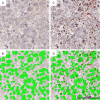PPIB/Cyclophilin B expression associates with tumor progression and unfavorable survival in patients with pulmonary adenocarcinoma
- PMID: 38455410
- PMCID: PMC10915315
- DOI: 10.62347/TYNU2341
PPIB/Cyclophilin B expression associates with tumor progression and unfavorable survival in patients with pulmonary adenocarcinoma
Abstract
Cyclophilin B (CypB), encoded by peptidylprolyl isomerase B (PPIB), is involved in cellular transcriptional regulation, immune responses, chemotaxis, and proliferation. Recent studies have shown that PPIB/CypB is associated with tumor progression and chemoresistance in various cancers. However, the clinicopathologic significance and mechanism of action of PPIB/CypB in non-small cell lung cancer (NSCLC) remain unclear. In this study, we used RNA in situ hybridization to examine PPIB expression in 431 NSCLC tissue microarrays consisting of 295 adenocarcinomas (ADCs) and 136 squamous cell carcinomas (SCCs). Additionally, Ki-67 expression was evaluated using immunohistochemistry. The role of PPIB/CypB was assessed in five human NSCLC cell lines. There was a significant correlation between PPIB/CypB expression and Ki-67 expression in ADC (Spearman correlation r=0.374, P<0.001) and a weak correlation in SCC (r=0.229, P=0.007). In ADCs, high PPIB expression (PPIBhigh) was associated with lymph node metastasis (P=0.023), advanced disease stage (P=0.014), disease recurrence (P=0.013), and patient mortality (P=0.015). Meanwhile, high Ki-67 expression (Ki-67high) was correlated with male sex, smoking history, high pT stage, lymph node metastasis, advanced stage, disease recurrence, and patient mortality in ADC (all P<0.001). However, there was no association between either marker or clinicopathological factors, except for old age and PPIBhigh (P=0.038) in SCC. Survival analyses revealed that the combined expression of PPIBhigh/Ki-67high was an independent prognosis factor for poor disease-free survival (HR 1.424, 95% CI 1.177-1.723, P<0.001) and overall survival (HR 1.266, 95% CI 1.036-1.548, P=0.021) in ADC, but not in SCC. Furthermore, PPIB/CypB promoted the proliferation, colony formation, and migration of NSCLC cells. We also observed the oncogenic properties of PPIB/CypB expression in human bronchial epithelial cells. In conclusion, PPIB/CypB contributes to tumor growth in NSCLC, and elevated PPIB/Ki-67 levels are linked to unfavorable survival, especially in ADC.
Keywords: Ki-67; Peptidylprolyl isomerase B; adenocarcinoma; non-small cell lung cancer; prognosis.
AJCR Copyright © 2024.
Conflict of interest statement
None.
Figures





References
-
- Siegel RL, Miller KD, Wagle NS, Jemal A. Cancer statistics, 2023. CA Cancer J Clin. 2023;73:17–48. - PubMed
-
- Rami-Porta R, Asamura H, Travis WD, Rusch VW. Lung cancer - major changes in the American Joint Committee on Cancer eighth edition cancer staging manual. CA Cancer J Clin. 2017;67:138–155. - PubMed
-
- Hou S, Zhou S, Qin Z, Yang L, Han X, Yao S, Ji H. Evidence, mechanism, and clinical relevance of the transdifferentiation from lung adenocarcinoma to squamous cell carcinoma. Am J Pathol. 2017;187:954–962. - PubMed
-
- Yun JK, Kwon Y, Kim J, Lee GD, Choi S, Kim HR, Kim YH, Kim DK, Park SI. Clinical impact of histologic type on survival and recurrence in patients with surgically resected stage II and III non-small cell lung cancer. Lung Cancer. 2023;176:24–30. - PubMed
LinkOut - more resources
Full Text Sources
Research Materials
